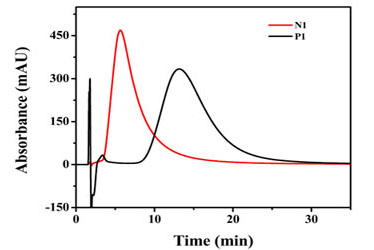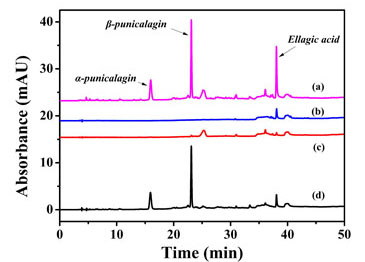Molecularly imprinting is a promising technique which simulates the specific interaction between enzymes and substrates in natural products. It can be used to prepare materials with specific selectivity for a determined target named as "template” that could be widely applied as adsorption in the solid-phase extraction (SPE) for sample concentration and identification.
Recently, the study of Chinese Medicine has drawn scientists' attention and brought challenge to the purification in natural products. Hence some research groups present an idea that molecularly imprinting could be used for compounds enrichment, separation and purification in natural products.
Pomegrante husk was regarded as a medicine to treat respiratory diseases due to its high content of natural antioxidants of polyphenols like ellagic acid and punicalagin. A research group led by Professor Haji Akber Aisa at Xinjiang Technical Institute of Physics and Chemistry of Chinese Academy of Sciences developed a cost-effecitive molecularly imprinting technique to purify punicalagin from pomegranate husk extract.
Researchers selected punicalin as the dummy template, in the presence of tetrahydrofuran and toluene as the porogen, polystyrene and polyethylene glycol as the co-porogen, molecularly imprinted polymers (MIPs) had been imprinted by in-situ polymerization and bulk polymerization and both of them had been verified to possess excellent imprinting effect, respectively.
Compared with the traditional imprinting method, this method had characteristics of extremely low consumption of the template (for 1 g molecularly imprinted polymer just 1 mg of punicalin was needed), high degree of imprinting effect (imprinting factor reach to 3.17) and an excellent imprinting capacity.
The researchers discovered punicalagin could be extracted by the above-mentioned technique with a satisfactory recovery reach to 85.3%, which provides a nice chose in sample pre-treatment. Besides, an interesting substrate named granatin A was also be found in high content in the washing fraction, which means that a good enriching efficiency of this substrate was also achieved.
These results showed that the method has great potential in purification of polyphenols, even in a future industrial application. The study was published in Journal of Separation Science.
This work was supported by the National Natural Science Foundation of China and Hundred Talent Program of the Chinese Academy of Science.

Fig. 1: The retention of punicalin on molecularly imprinted monolith (P1) and relative non-imprinted monolith (N1) .(Image by XTIPC)

Fig. 2: Chromatograms of (a) pomegranate husk extracts (b) washing 1 (c) washing 2 (d) elution of the SPE on C18 column. (Image by XTIPC)
Contact:
Prof. Haji Akber Aisa
E-mail: haji@ms.xjb.ac.cn
Xinjiang Technical Institute of Physics & Chemistry,CAS
